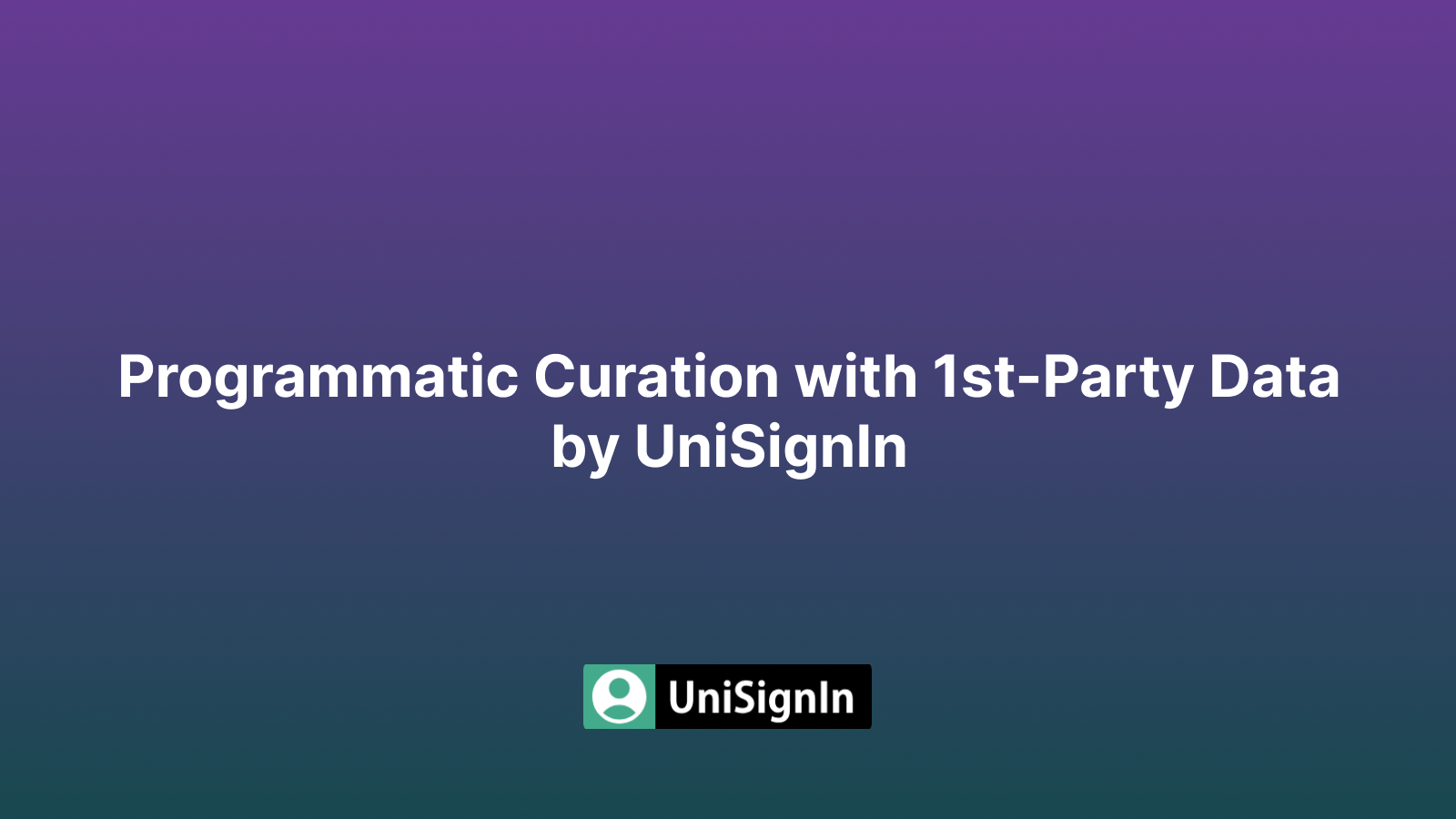Programmatic Curation with First-Party Data by UniSignIn
UniSignIn Platform

Programmatic curation is transforming how advertisers connect with their target audiences. By enabling advertisers to curate custom media packages using first-party and contextual data, this approach allows for more precise targeting of specific audience segments. Programmatic curation fosters closer collaboration with publishers and leverages privacy-compliant data, enhancing transparency, reducing reliance on third-party cookies, and improving the accuracy of media buys. The result is optimized ad placements and enhanced campaign performance. UniSignIn empowers publishers to gain insights, collect, manage, and create audience segments using first-party data with explicit user consent for programmatic curation.
New Programmatic Curation
Traditionally, programmatic deal curation involved packaging publisher inventory into private marketplaces (PMPs) and enhancing it with audience data, often sourced through demand-side platforms (DSPs) using third-party cookies. However, with the phasing out of third-party cookies and rising concerns about data privacy, the industry is shifting towards a sell-side curation model.
Many supply-side platforms (SSPs) have launched dedicated curation services. This transition allows for better use of first-party data and contextual signals, providing increased transparency and improved targeting while addressing concerns over inventory quality on the open web. UniSignIn helps publishers unlock more value from their first-party data.
Benefits of Using Programmatic Curation
- Increased transparency
By working closely with sell-side partners, advertisers gain greater visibility into ad placements. This collaboration enhances transparency around audience segments and supply, helping advertisers avoid brand-unsafe placements, low-quality sites (MFA), and underperforming inventory. Through participation in selective marketplaces, advertisers can be more selective about where their ads appear, gaining better control over media buys.
- Enhanced targeting
First-party data enables more accurate audience creation. Publishers have deep insights into user behavior and can leverage these insights for first-party audience matching. Combining high-quality contextual publishers with first-party or third-party audience data at scale enhances inventory value. This approach can increase reach and effectiveness, with some clients reporting reach improvements of 25% to 40% when using sell-side audiences, according to Microsoft.
- Privacy-compliant strategies
Programmatic curation minimizes reliance on third-party cookies by focusing on user consent and first-party data. This shift is crucial in a post-GDPR world, where data privacy is driving campaign strategies away from behavioral targeting toward content-based signals. ID graph matching between advertisers, publishers, and third-party brokers becomes more efficient on the sell side, ensuring compliance with global regulations while maintaining high-quality data.
- Optimized ad performance
Higher-quality inventory combined with better audience matching drives improved campaign performance. Sell-side curation allows for more granular targeting, particularly beneficial for advertisers with strict placement requirements, such as alcohol brands. By merging curation with contextual and audience data, advertisers can unlock greater value on the publisher side, leading to better monetization for publishers and more successful outcomes for advertisers.
Kickstart Your Programmatic Strategy with UniSignIn
UniSignIn simplifies programmatic curation by offering tools for first-party data collection, management, analysis, and audience segmentation. Through integrated Single Sign-On (SSO) and audience management capabilities, UniSignIn allows advertisers to build and activate high-quality user profiles while ensuring privacy compliance. This leads to more personalized ad strategies tailored to audience interests.
- Maximizing First-Party Data
UniSignIn empowers publishers to collect, manage, and analyze first-party data, enabling them to build detailed audience segments. By leveraging this data, publishers can offer advertisers more precise targeting options, driving deeper audience engagement and enhancing campaign performance.
- Custom Private Marketplaces (PMPs)
UniSignIn allows publishers to create custom Private Marketplaces (PMPs), offering premium inventory across various devices and formats. This provides publishers with the flexibility to package high-quality audiences for advertisers, increasing the value of their inventory and maximizing revenue potential.
- Privacy-First Strategy
UniSignIn helps publishers implement privacy-first strategies by ensuring compliance with global data protection regulations, such as GDPR and CCPA. By focusing on user consent and leveraging first-party data, publishers can maintain data integrity while supporting advertisers in navigating complex privacy requirements.
- Contextual Targeting
UniSignIn enables publishers to combine first-party data with contextual signals, offering advertisers highly relevant ad placements. This approach enhances the relevance of ads shown to users, improving engagement and overall campaign success, while increasing the value of the publisher’s inventory.
About UniSignIn
UniSignIn is part of Transfon’s privacy-first User Experience Platform, designed to provide seamless and transparent user data management in the post-GDPR world. Our tools power both advertisers and publishers with data-driven, privacy-compliant solutions for programmatic curation. Learn more at UniSignIn.
Everything you need
All-in-one platform
UniSignIn is all-in-one first-party data platform to collect and manage the first-party data of your digital assets.
- Social Login with Google Login
- Social Login with Facebook Login
- Social Login with Twitter Login
- First-party data analysis
- First-party data onboarding and management
- Single Sign-On with Email and password
- User experience orchestration engine
- Personalised Email and communication
- First-party data collector
- First-party tag management

